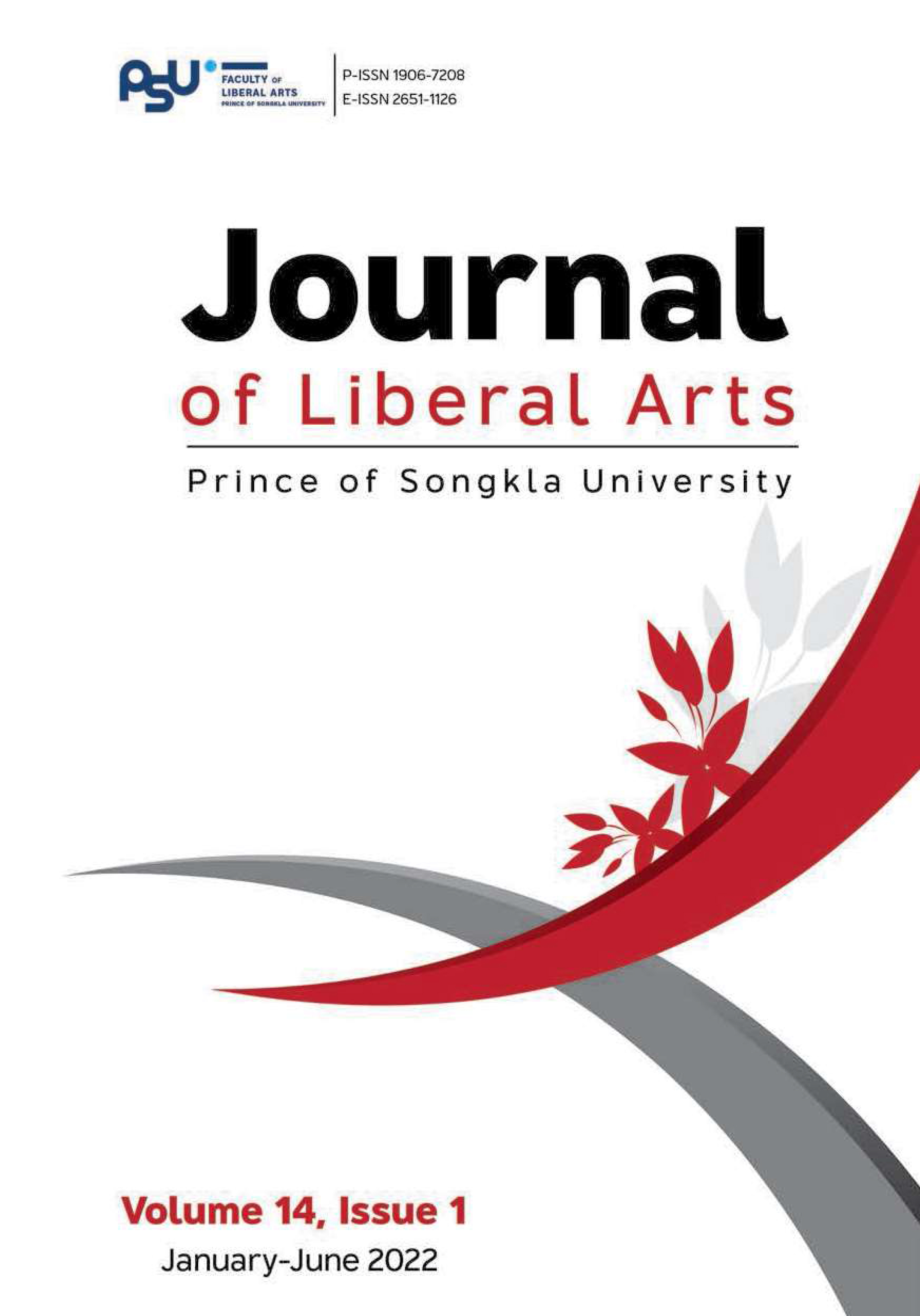Factors Predicting the Organizational Loyalty Among Private School Teachers in Hat Yai District, Songkhla Province
DOI:
https://doi.org/10.14456/jlapsu.2022.9Keywords:
private teacher, perceived organization support factors, interpersonal relationship, psychological factors, SongkhlaAbstract
This study examined the relationships among several factors of organizational loyalty which included perceived organizational support, interpersonal relationships, and psychology. The participants were 234 private school teachers in Hat Yai District, Songkhla Province. The instrument used was a 5-point Likert Scale questionnaire covering five parts: general information, perceived organizational support, interpersonal relationship, happiness at work, and organization commitment. The R program was utilized to determine the mean and standard deviation. Meanwhile, Pearson's correlation coefficient was administered to investigate the relationships among the factors. The results revealed that: 1. Happiness at work had a positive relationship with organizational loyalty of private school teachers in Hat Yai, Songkhla (level of significance: 0.001). 2. Job advancement, relationships with the colleagues and principals, and organization commitment had a positive relationship with the organizational loyalty of private school teachers in Hat Yai, Songkhla (level of significance: 0.01). 3. Policy, administration, and work environment had a positive relationship with organizational loyalty of private school teachers in Hat Yai, Songkhla (level of significance: 0.05). 4. Compensation, benefits, and Job security had no relationship with organizational loyalty of private school teachers in Hat Yai, Songkhla.
References
Akerlof, G., & Yellen, J. (1990). The fair wage-effort hypothesis and unemployment. Quarterly Journal of Economics, 105, 255-83. https://doi.org/10.2307/2937787
Akerlof, G. (1982). Labor contracts as a partial gift exchange. Quarterly Journal of Economics, 97, 543-69. https://
doi.org/10.2307/1885099
Akerlof, G. A., & Kranton, R. E. (2005). Identity and the economics of organizational. Journal of Economic Perspectives, 19(1),
-32. https://doi.org/10.1257/0895330053147930
Allen, N.J., & Meyer, J.P. (1990). The measurement and antecedents of affective, continuance, and normative commitment to the organization. The Journal of Occupational Psychology, 63, 1-18. https://bpspsychub.onlinelibrary.wiley.com/doi/10.1111/j.2044-8325.1990.tb00506.x
Athey, S., & Roberts, J. (2001). Organizational design: Decision rights and incentive contracts. American Economic Review, 91(2), 200-205. https://doi.org/10.1257/aer.91.2.200
Bakker, A. B., & Schaufeli, W. B. (2008). Positive organizational behavior: Engaged employees in flourishing organizations. Journal of Organizational Behavior, 29(2), 147–154. https://doi.org/10.1002/job.515
Blau, P.M. (1964). Exchange and power in social life. John Wiley.
Di Marco, N.J. (1974). Supervisor-subordinate lifestyle and interpersonal need compatibilities as determinants of subordinate attitudes toward the supervisor. Academy of Management Journal, 17(3), https://doi.org/10575..17010/pijom/2016/v9i7/97783
Elegido, J. M. (2013). Does it make sense to be a loyal employee? Journal of Business Ethics, 116(3), 495–511. https://www.
jstor.org/stable/42001938
Fisher, C. D. (2010). Happiness at work. International Journal of Management Reviews, 12, 384-412.https://doi.org/10.1111/
j.1468-2370.2009.00270.x
Fisher, S.G., Macrosson, W.D.K., & Walker, C.A. (1995). FIRO-B: the power of love and the love of power. Psychological Reports,195-206. https://doi.org/10.2466/pr0.1995.76.1.195
Furnham, A. (1990). The fakeability of the 16-PF, Myers-Briggs and FIRO-B personality measures. Personality and Individual Differences, 11(7), 711–716. https://doi.org/10.1016/0191-8869(90)90256-Q
Furnham, A. (1996). The FIRO-B, the learning style questionnaire, and the five-factor model. Journal of Social Behavior & Personality, 11(2), 285–299. https://doi.org/10.2466/pr0.2000.86.1.311
Gavin, J.H., & Mason, R.O. (2004). The value of happiness in the workplace. Organizational Dynamics, 33, 379-392. https://doi.org/10.1016/j.orgdyn.2004.09.005
Green, F. (2008). Leeway for the loyal: A model of employee discretion. British Journal of Industrial Relations, 46(1), 1-32. https://doi.org/10.1111/j.1467-8543.2007.00666.x
Gupta, V. (2012). Importance of being happy at work. International Journal of Research and Development, 1(1), 9-14. http://www.irdindia.in/journal_ijrdmr/pdf/vol1_iss1/2.pdf
Hari, A. (2018). 71 Karyawan di Indonesia mengaku bahagia dengan pekerjaannya. Retrived March 3, 2021 from, http://www.intipesan.com/71-karyawan-di-indonesia-mengaku-bahagia-dengan-pekerjannya/
Hewett, T.T., & O'Brien, G.E. (1974). The effects of work organization, leadership style, and member compatibility upon the productivity of small groups working on a manipulative task. Organizational behavior and human performance, 11(2), 283. https://doi.org/10.1016/0030-5073(74)90021-X
Hill, R.E. (1974). Managing interpersonal conflict in project teams. Sloan Management Review, 18(2), 45. https://deepblue.
lib.umich.edu/bitstream/handle/2027.42/35721/b1374011.0001.001.pdf?sequence=2&isAllowed=y
Hurley, J.R. (1990). Does FIRO-B relate better to interpersonal or intrapersonal behavior? Journal of Clinical Psychology, 46(4),454-460. https://onlinelibrary.wiley.com/doi/10.10 02/1097-4679(199007)46:4%3C454::AIDJCLP2270460413%3E3.0.CO;2-K
Ilgen, D.R., & O'Brien, G. (1974). Leader-member relations in small groups. Organizational Behavior and Human Performance, 12(3),335. https://doi.org/10.1016/0030-5073(74)90056-7
Kaewkhunthod, U. ( 2007). Leader trust, organizational trust and organizational loyalty affecting behavior and performance efficiency of employees in NetBKK Co, LTD. Srinakharinwirot University, Bangkok. [in Thai]
Kim, H., & Lee, S. Y. (2009). Supervisory communication, burnout, and turnover intention among social workers in health care settings. Social Work in Health Care, 48(4), 364- 385. https://doi.org/10.1080/00981380802598499
Kobkhuntod, S., Fongtanakit, R., & Burananuth, N. (2019). Work happiness factors of condominium employees Phuket Province. Journal of the Association of Research. 24(3), 41-56. [in Thai]
Logan, G. M. (1984). Loyalty and a sense of purpose. California Management Review, 27(1), 149–156. https://doi.org/
2307/41165119
Mapoppan, B. (2001). Factors affecting organizational engagement: A case study of Unocal Thailand Company Limited [Unplublished
master’s thesis]. Chulalongkorn University. [in Thai]
Meyer, J. P., Allen, N. J., & Smith, C. A. (1993). Commitment to organizations and occupations: Extension and test of a
three component conceptualization. Journal of Applied Psychology, 78, 538-51. https://doi.org/10.1037/0021-9010.78.4.538
Meyer, J. P., Stanley, D. J., Herscovitch, L., & Topolnytsky, L. (2002). Affective, continuance, and normative commitment to the organization: A meta-analysis of antecedents, correlates, and consequences. Journal of Vocational Behavior, 61, 20-52. https://doi.org/10.1006/jvbe.2001.1842
Muenchana., R. (1995). Business Psychology (2nd Ed). Odeon Store. [in Thai]
Naus, F., Van Iterson, A., & Roe, R. (2007). Organizational cynicism: Extending the exit, voice, loyalty, and neglect model of employees’ responses to adverse conditions in the workplace. Human Relations, 60(5), 683–718. https://doi.org/10.1177/0018726707079198
Pengsawang, C. (2010). The relationship between perfectionism and happiness at work of employees, asset management at financial institutions [Unpublished master’s thesis]. University of Technology King Mongkut. [in Thai]
Peretti, J.M., & Igalens, J. (2015). Dictionnaire des ressources humaines (7th ed.), 110. Vuibert.
Phothong, R. (2014). A study of personal qualities of leadership and working atmosphere affecting employee engagement in operational level organizations in Samut Prakan [Unpublished master’s thesis]. Bangkok University. [in Thai]
Phramaha, P. T. (2021). Process to strengthen the loyalty of personnel in educational institutions. Journal of Educational Innovation and Research. 5(3), 709-718. [in Thai]
Price-Jones, J. (2010). Happiness at work: Maximizing your psychological capital for success. Wiley. http://journals
.sfu.ca/rpfs/index.php/rpfs/article/download/129/128
Pumpaka, R. (2022). The loyalty of the employee in Bangkok Mass Transit System Public Company Limited [Unpublished master’s thesis]. Ramkhamhaeng University. https://mmm.ru.ac.th/MMM/IS/twin92/6214154721.pdf [in Thai]
Rezaeian, A. (1995). Organizational behavior management [Unpublished master’s thesis]. Tehran University.
Rice University. (2012). What employees owe Employers, Business Ethics, Copyright Rice University, OpenStax, under CC BY 4.0 license. https://opentextbc.ca/businessethicsopenstax/chapter/loyalty-to-the-company/
Safra, J. E. (2007). The New encyclopaedia britannica (15th Ed.). Encyclopaedia Britannica.
Schutz, W. C. (1966). The interpersonal underworld: By william C. Schutz. Palo Alto.
Seligman, M.E.P., & Csikszentmihalyi, M. (2000). Positive psychology: An introduction. American Psychologist, 55(1), 5–14. https://doi.org/10.1037/0003-066X.55.1.5
Smith, P.B., & Linton, M.J. (1975). Group composition and changes in self-actualization in t-groups. Human Relations, 28(9), 811.
Songkhla Primary Educational Service Area District Office 2. (2016). General information. Songkhla: Songkhla Primary Educational Service Area Office 2. Retrived Dec 3, 2020, from http://www.ska2.go.th [in Thai]
Srira, K. (2021). Factors affecting loyalty to the government organization in Angthong City Hall. Ramkhamhaeng Journal of Public Administration. http://www.mpa-mba.ru.ac.th/images/Project/treatise_lopburi01_02082021/6124952484.pdf [in Thai]
Sukhothai Thammathirat Open University. (1997). Collection of courses theories and practices in educational management. (2nd printing). Sukhothai Thammathirat Open University.
Sverke, M., & Goslinga, S. (2003). The consequences of job insecurity for employers and unions: Exit, voice and loyalty. Economic and Industrial Democracy, 24(2), 241–270. https://doi.org/10.1177/0143831X03024002005
Tasnim, Z. (2016). Happiness at workplace: building a conceptual framework. World Journal of Social Science. 6(2), 62-70. http://www.wjsspapers.com/static/documents/July/2016/6.%20Zerin.pdf
Wesarat, P., Sharif, M. Y., & Majid, A. H. A. (2015). A conceptual framework of happiness at the workplace. Asian Social Science, 11(2),78-88. https://doi.org/10.5539/ass.v11n2p78
Zaki, M.A. (2006). A survey and assessment on organizational support, The Economical and Official Science Faculty Magazine,3.
Downloads
Published
How to Cite
Issue
Section
License
Copyright (c) 2022 Nattha Lertpanyawiwat, Kasetchi Leaheem, Kanda Janyam

This work is licensed under a Creative Commons Attribution-NonCommercial-NoDerivatives 4.0 International License.
The authors retain the copyright to their article but the Journal of Liberal Arts, Prince of Songkla University reserves the exclusive rights to first publication.




